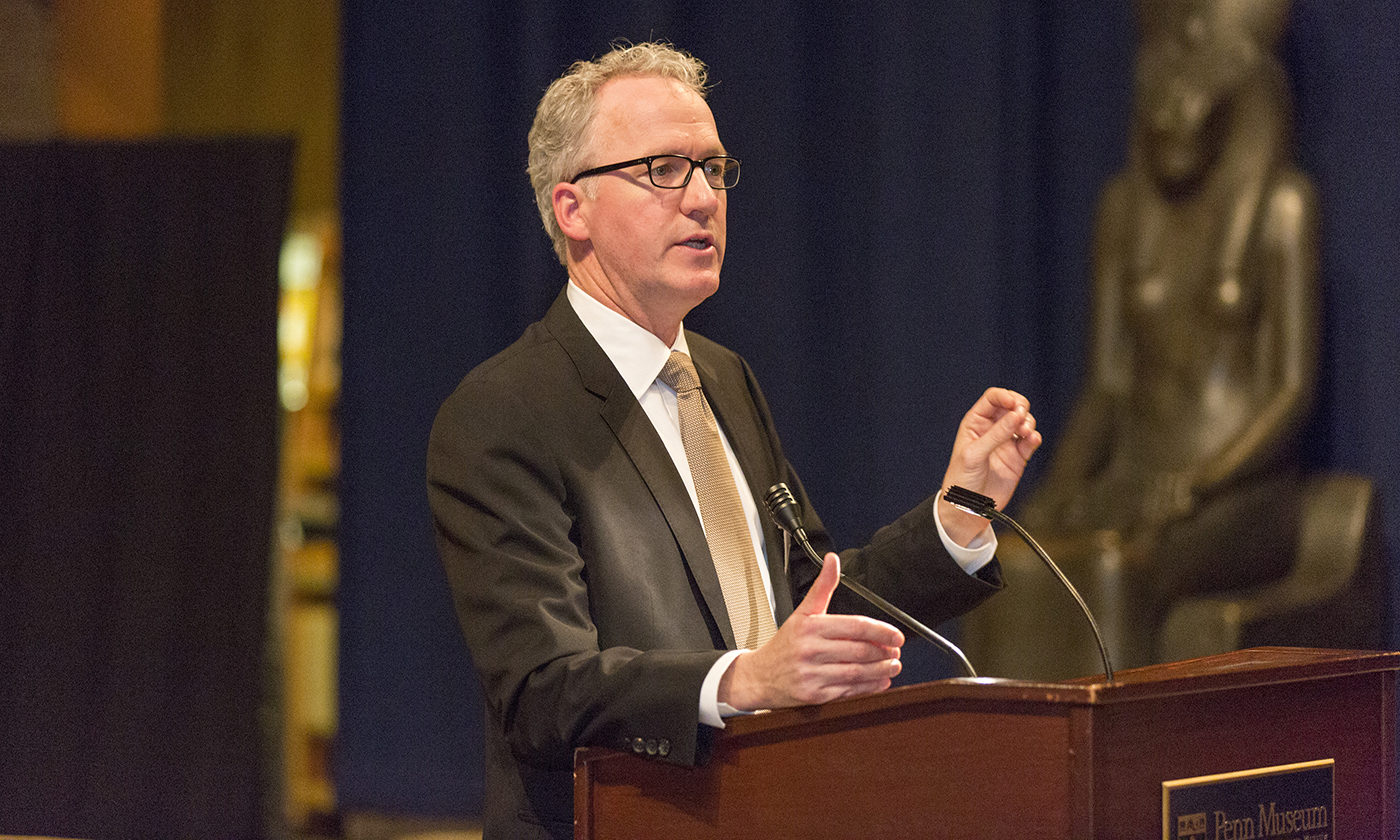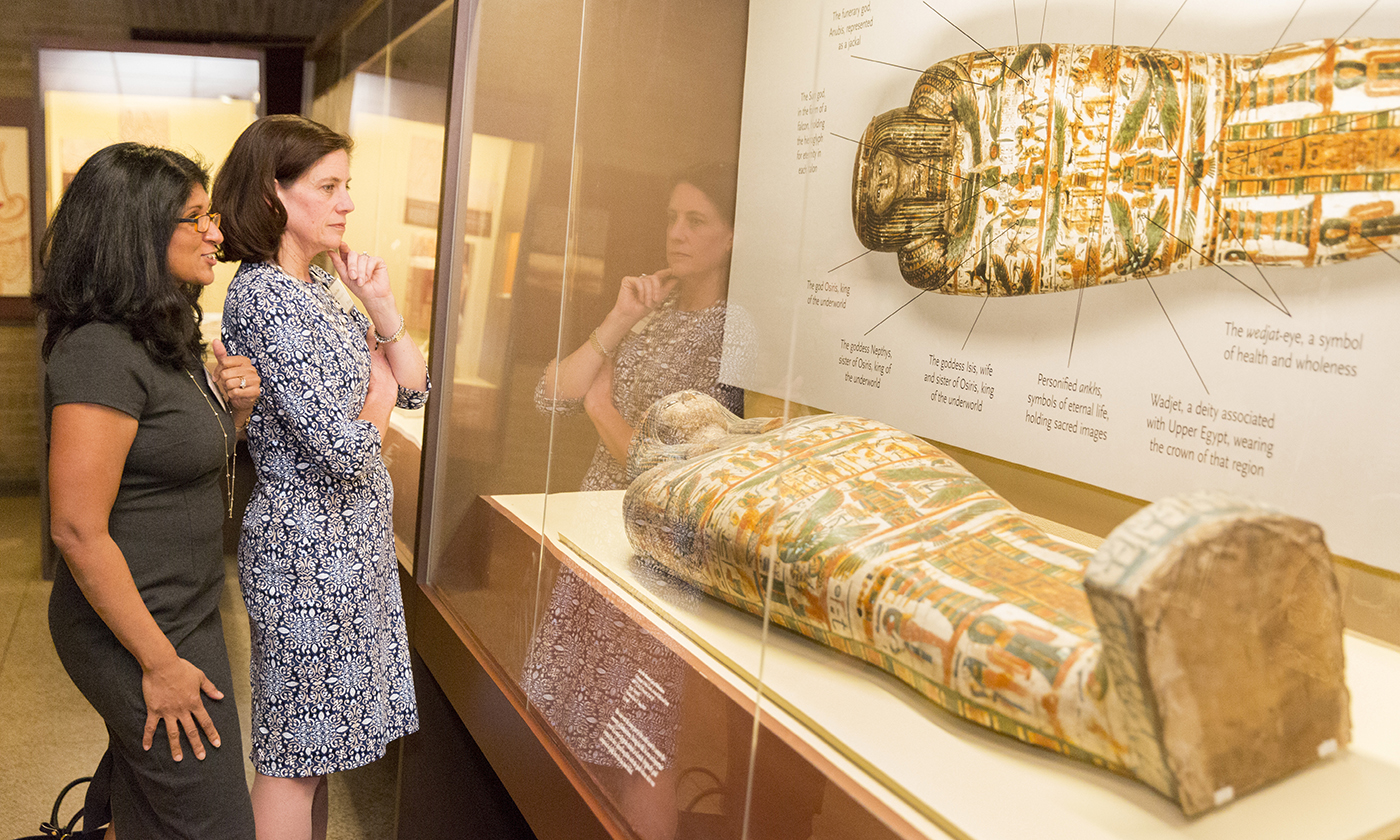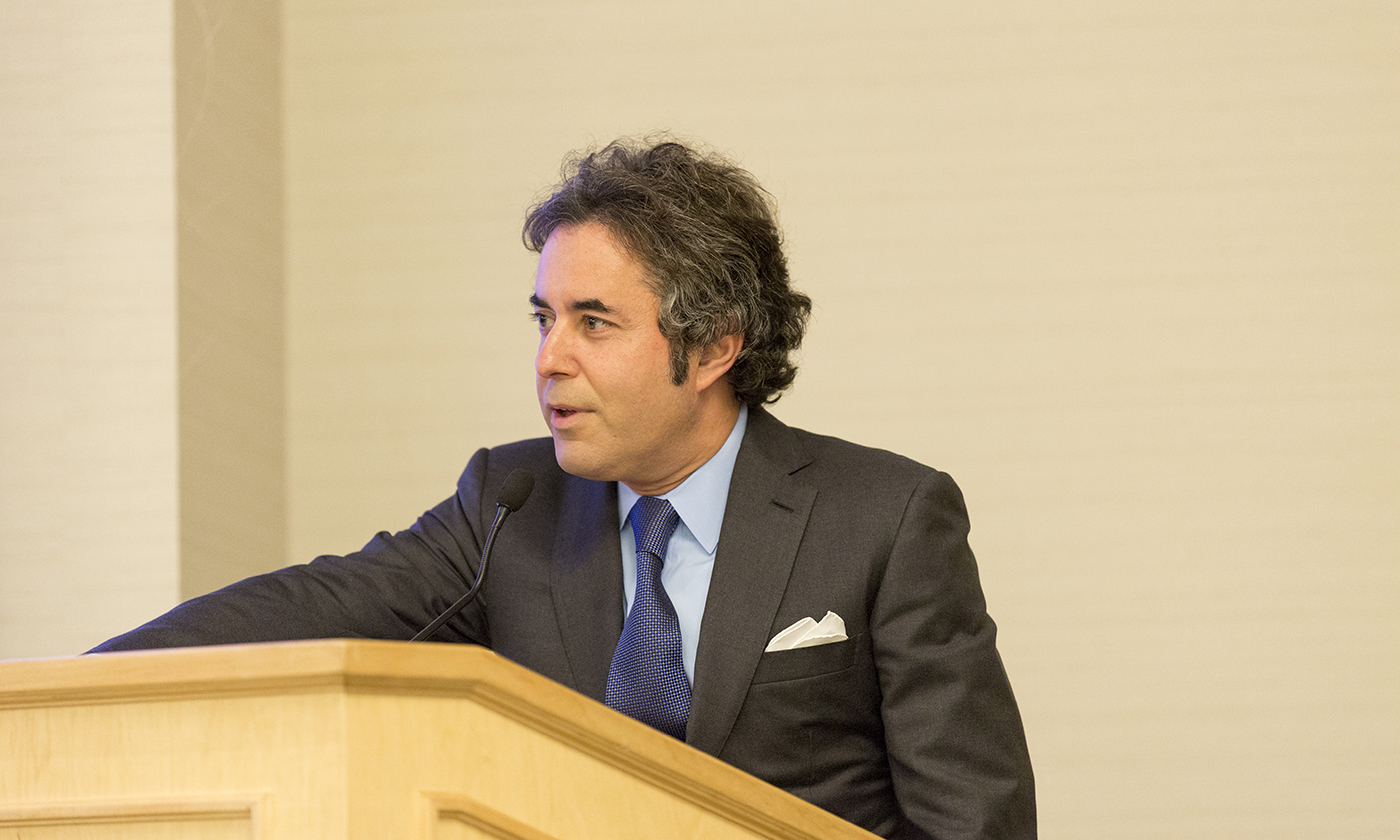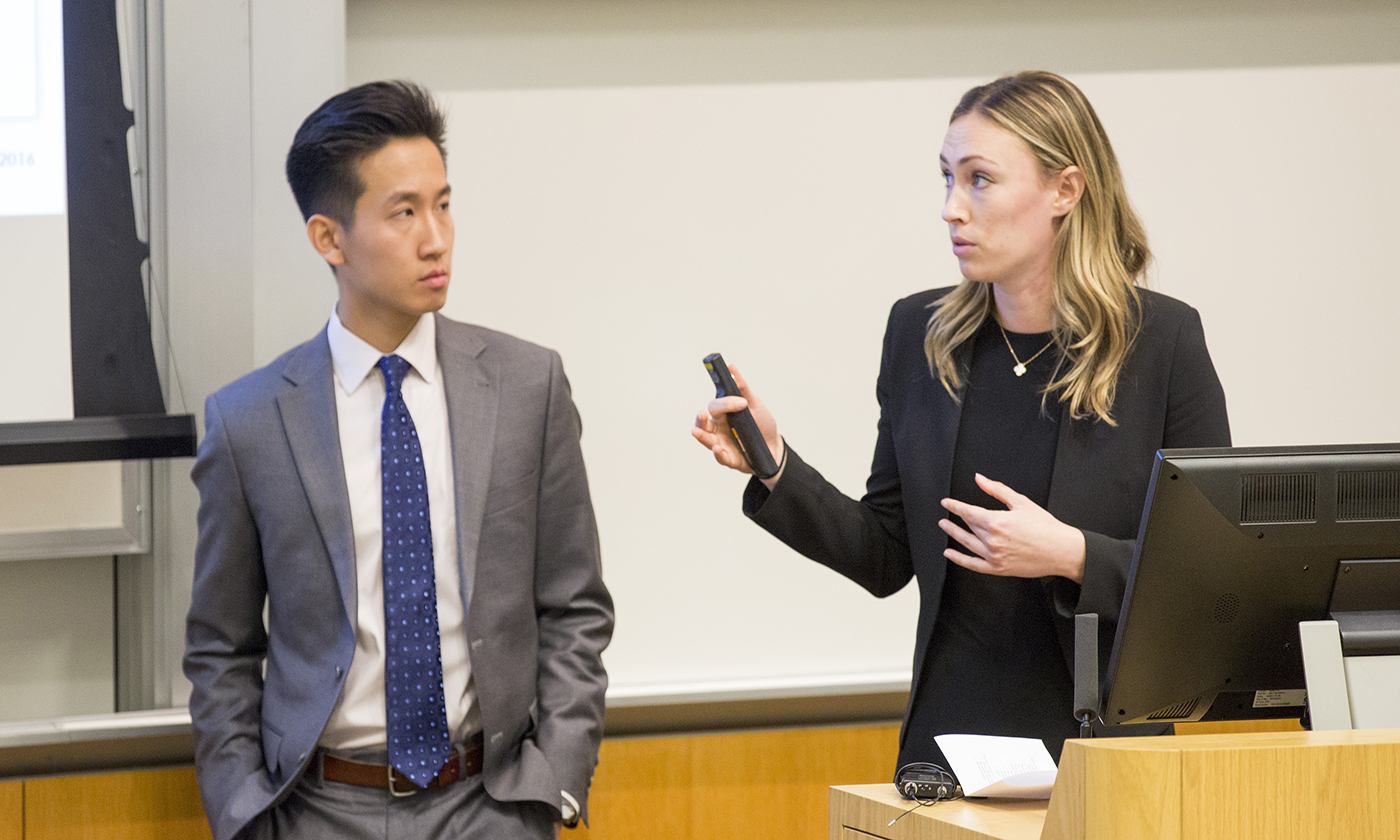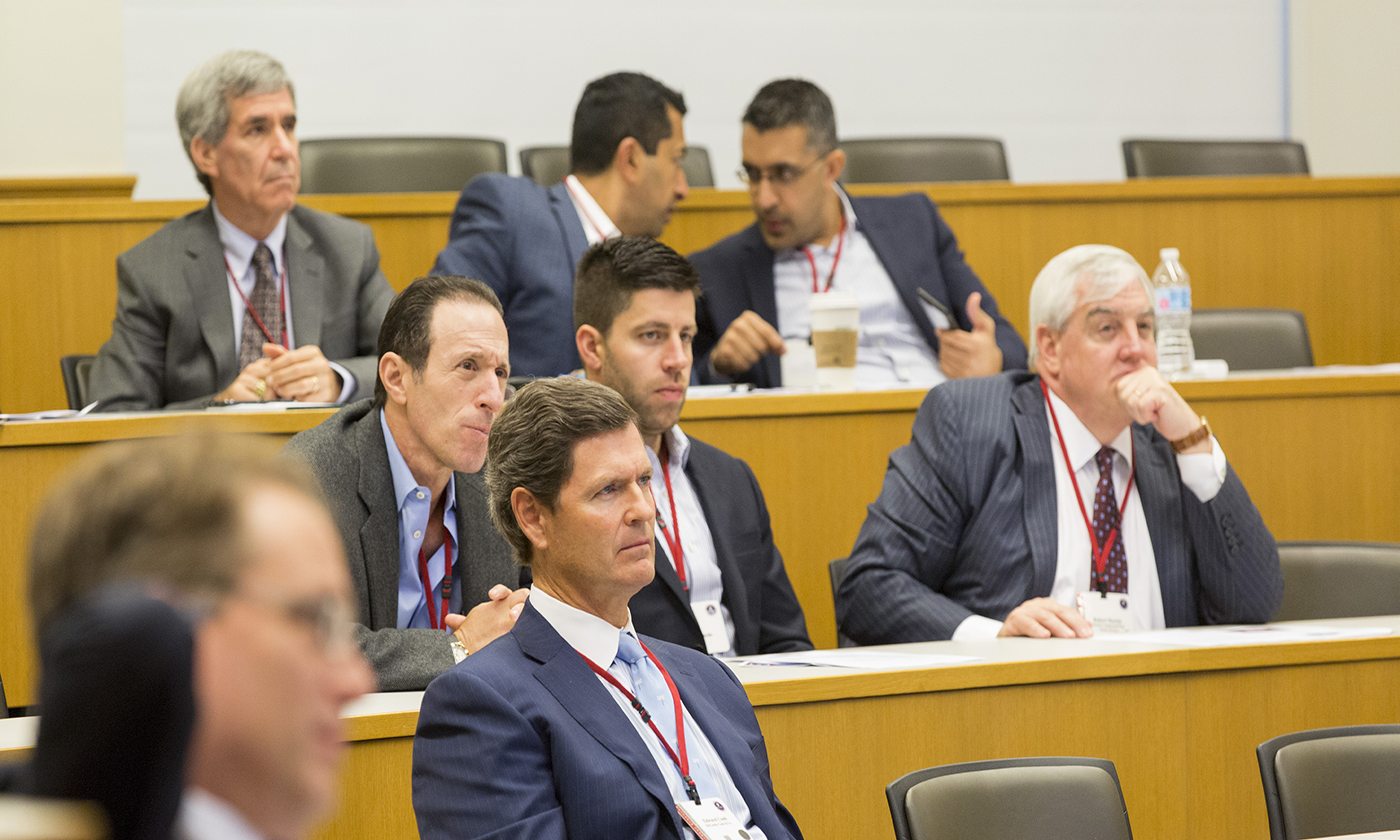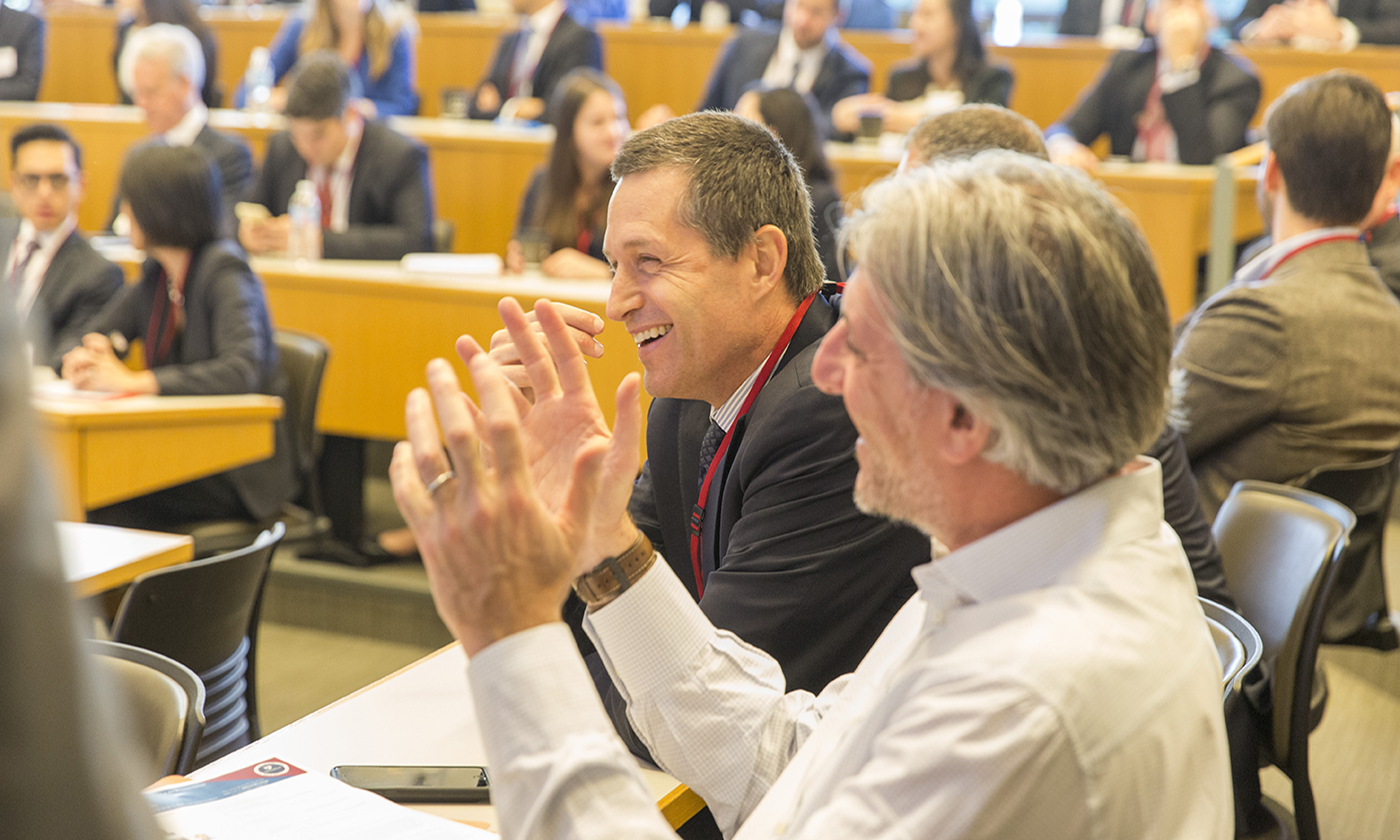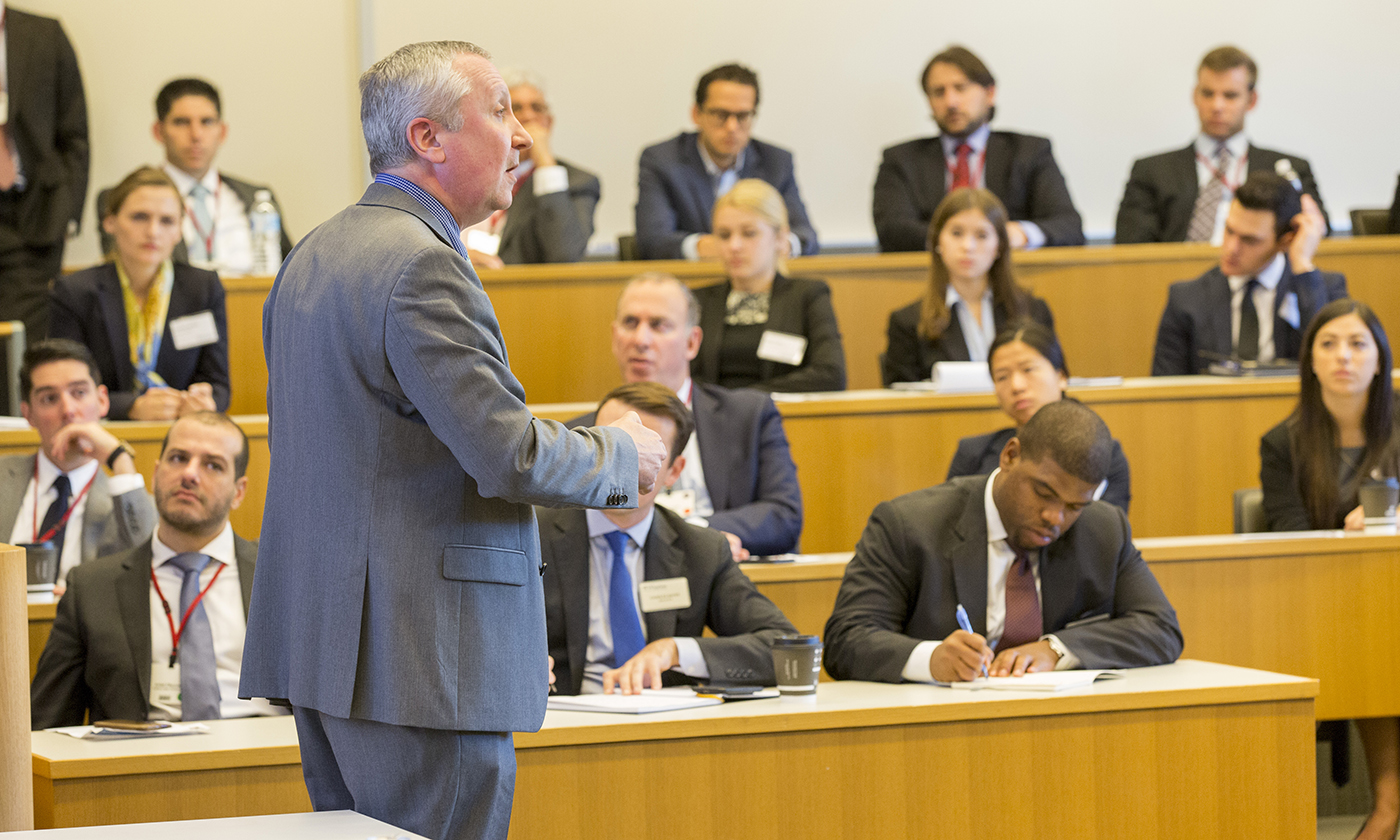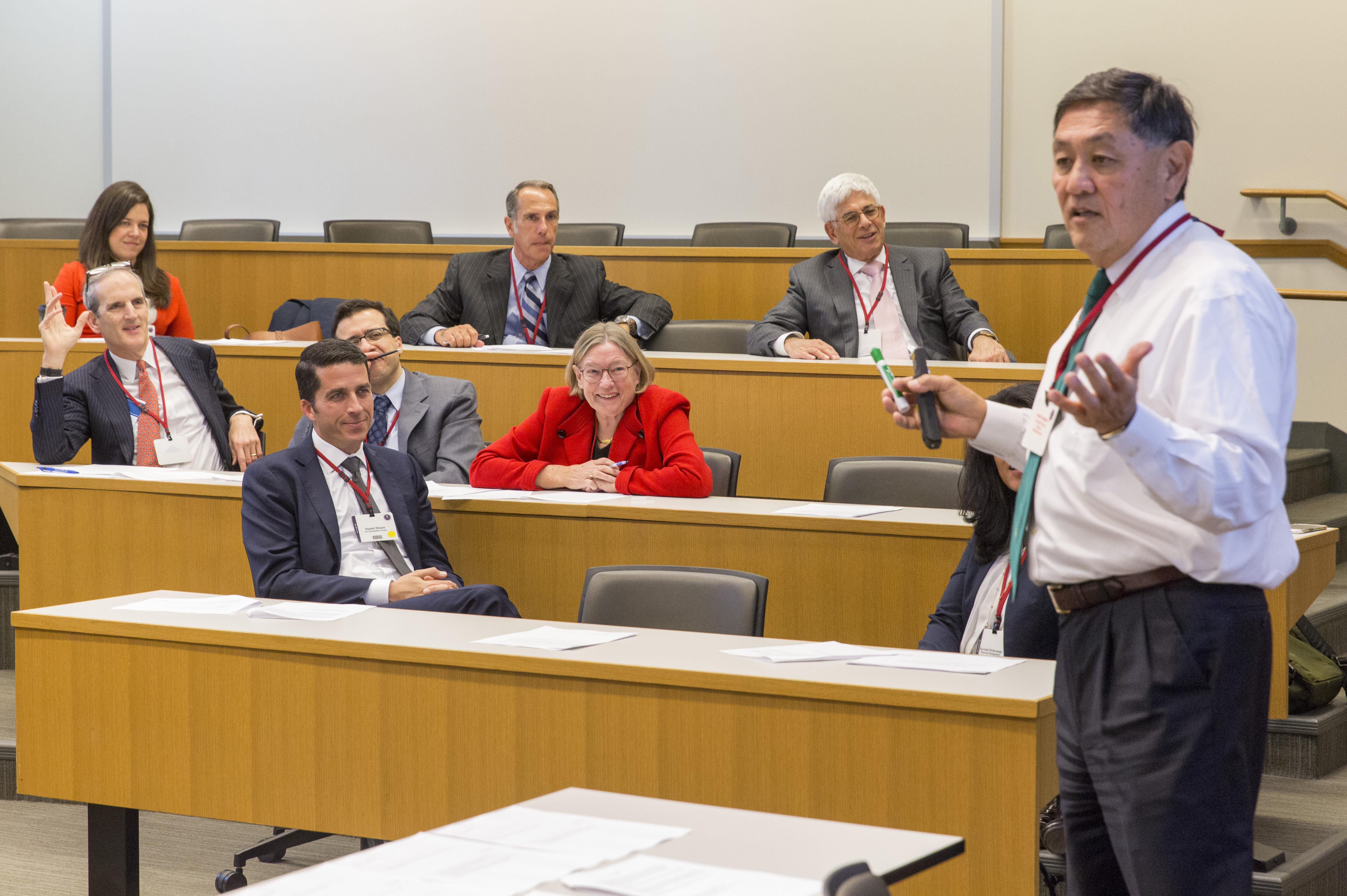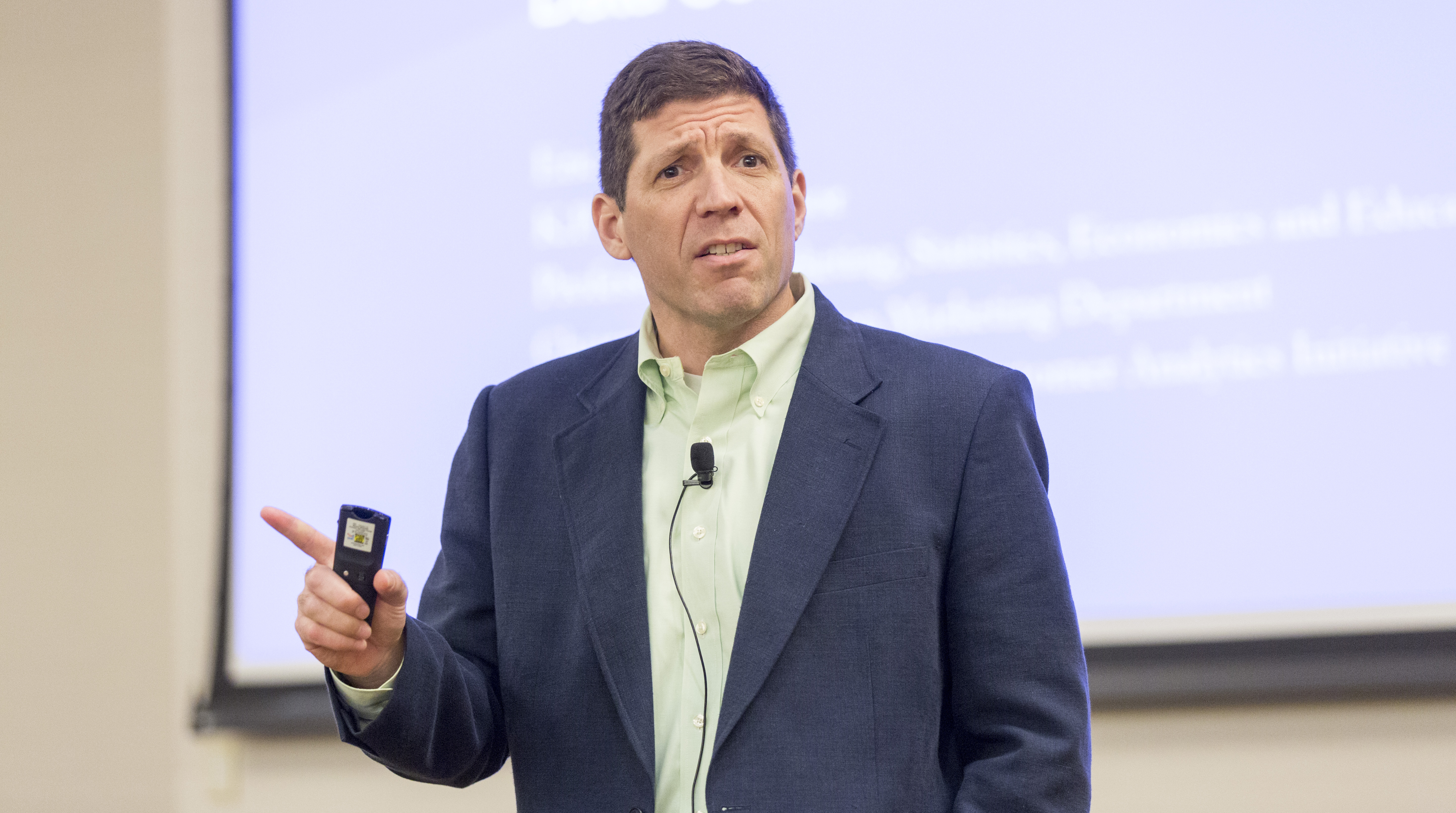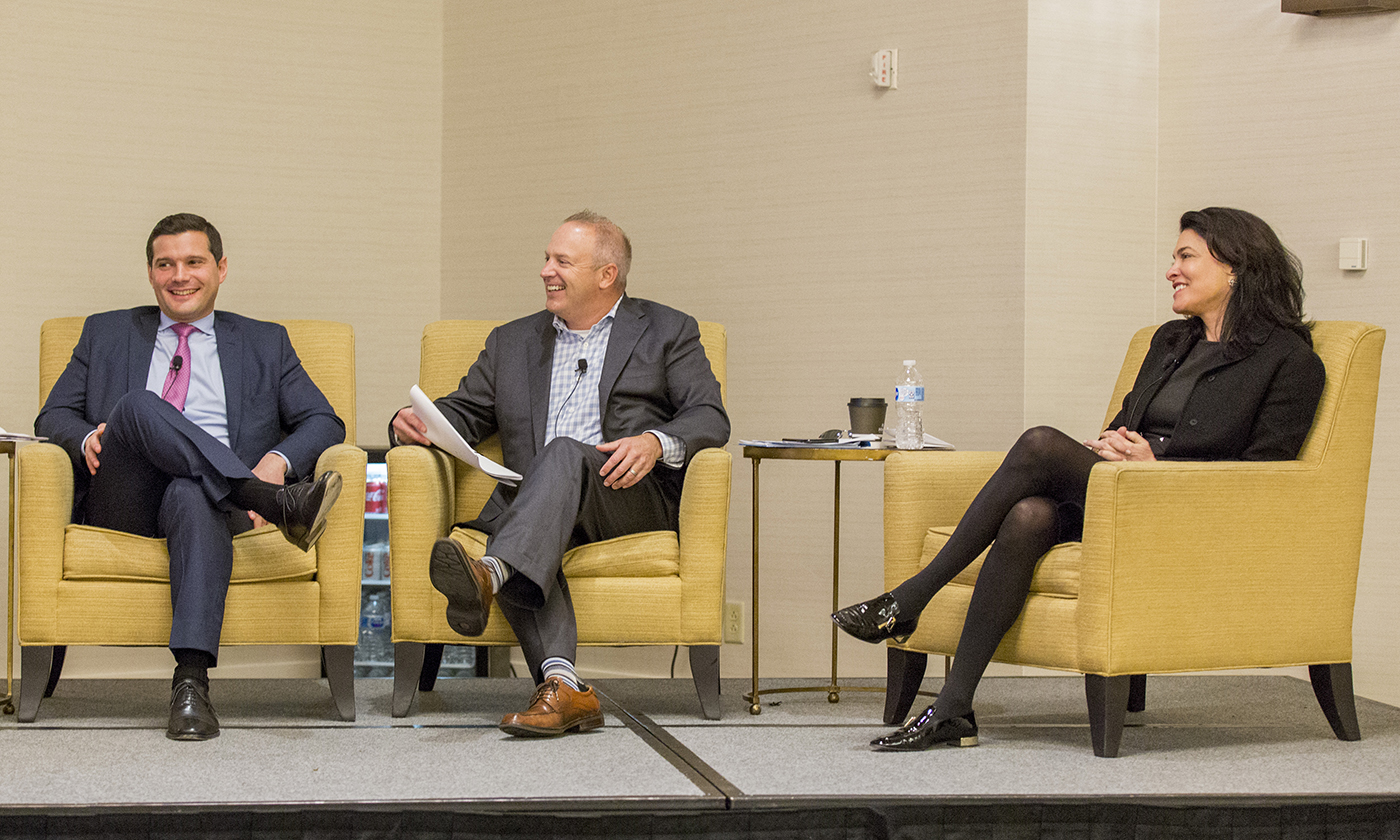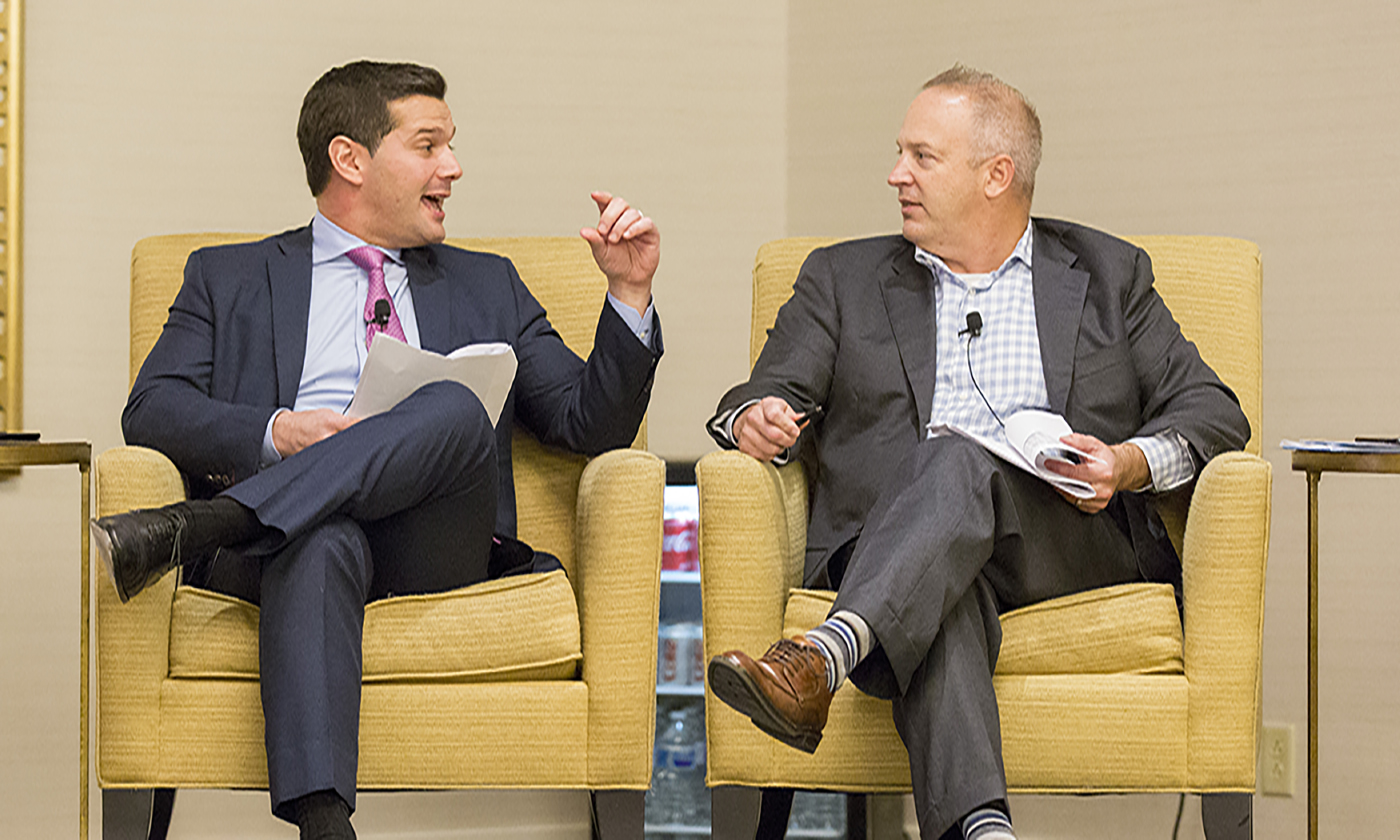2017 Fall Members’ Meeting Summary
Thursday, October 26 – Friday, October 27, 2017
The Zell/Lurie 2017 Fall Members’ Meeting began with a dinner and talk for Zell/Lurie Research Sponsors, Executive Committee members and guests at the University of Pennsylvania Museum of Archaeology and Anthropology. Cade Massey, Practice Professor in the Wharton School’s Operations, Information and Decisions Department, gave an engaging and informative talk on “Hiring in the Age of Technology: Process, Promises & Pitfalls.” Afterwards guests had the opportunity to tour several of the exhibits offered by the museum.
The following day’s meeting opened with a continental breakfast, during which mentors met with their student mentees and other guests had the opportunity to network.
Spencer B. Haber, Chief Executive Officer, H/2 Capital Partners LLC, and Chair of the Advisory Board for the Zell/Lurie Real Estate Center at the Wharton School, provided welcoming remarks. Haber announced that the Center’s programming has gone global, with the first European meeting taking place in London four years ago with one about to take place in Asia in 2018. Haber also announced that Susan Sessa had been promoted to Managing Director of the Center.
Joe Gyourko, Martin Bucksbaum Professor of Real Estate, Finance and Business Economics & Public Policy and Nancy A. Nasher and David J. Haemisegger Director of the Zell/Lurie Real Estate Center; gave a brief address on the state of the Center. He discussed its mission and membership statistics including programs for members and talked about the Grayken Program in International Real Estate, announcing Professor Maisy Wong as the new Assistant Director for that program.
Susan Sessa then spoke about the Center’s new website (same URL: http://realestate.wharton.upen.edu/ ) and reminded members about the resume book, which is an excellent resource and can be found on the site.
The first panel, “The New Game—Creating Real Estate Value without Owning the Real Estate,” was moderated by Asuka Nakahara, the Center’s Associate Director. Panelists were Dave McLaughlin, General Manager East and Canada for WeWork, and Ania Smith, Head of Business Operations, North America, for Airbnb.
McLaughlin, who began his career as a screenwriter and filmmaker, talked about WeWork as a “broad movement.” He is responsible for eight markets comprising 31,000 desks (rental units) and 300 employees. Smith, a Wharton graduate, focuses her attention on maintaining and building quality and options offered to Airbnb hosts, globally, and managing online and off-line programs for them as well as planning for consistently excellent guest experiences.
“It’s all about building an end-to-end beautiful travel experience for our guests,” she said. “Now we’re adding trip experiences and guides as well as the homes. Nourishing the community of hosts and guests is what makes Airbnb a special place to be.”
“WeWork is a platform for creators, entrepreneurs, non-profit founders, people driving and creating growth and having an impact in various fields,” explained McLaughlin. “We offer a platform for those people to use space and plug into a like-minded community with value-added services on top of that.”
WeWork has 150,000 members worldwide. In a recent survey, 70 percent of them have collaborated with other members and 50 percent have done some sort of transaction—sourcing vendors, doing business development, hiring each other, recruiting and more. “It’s a rich community that includes space delivered efficiently.”
Asuka Nakahara wondered what new developments are in progress with each company. “You must have a filter to make sense of the new ideas that must come to your company all the time,” he said.
Smith described a joint venture with New Guard, an apartment complex of 300 units in Florida that owners can rent for a specified number of nights per year. It will include amenities such as check-in and check-out services, pool, gym and cleaning, making it seem like a hotel—but it won’t be a hotel because each apartment is privately owned and uniquely decorated.
“We can offer services to the landlord too and help them realize revenue they haven’t had before,” she said.
McLaughlin said there has been a growing demand from established companies requesting collaboration with WeWork to help with certain aspects of their business. “They have a lease and building and are good at what they do, but may not be good at other things like the community culture and business growth in that area … they propose we combine WeWork’s ideas with their business and provide on-site solutions.”
Nakahara asked how they think about real estate. “After all, you need real estate for employees and business purposes.”
McLaughlin agreed that real estate is a functional requirement for what WeWork does. New developments within their company (WeLive, coding bootcamp and others) are all built on top of real estate and how to use their existing spaces to implement their other goals. “Real estate is opportunistic for us and super strategic,” he said. “Accessibility is a key driver in our workforce.”
Smith got a laugh when she said that she and her colleagues never use the term “real estate” at Airbnb. “We think about ‘homes’ instead,” she said. “Where are they? How can we get more homes? How do we continue growing that community?” She added that although it’s not part of their core business, they work with real estate partners all the time and would like to do more deals like the one currently underway in Florida.
When it comes to competitors, Smith conceded that the market has changed and they may face threats from Google and Amazon, but she believes that changes Airbnb is making to its structure—trip planning, restaurant reservations, additional amenities—will cause travelers to search Airbnb first.
“It does seem that the culture and community that you’ve got makes it hard for others,” said Nakahara. He then asked where they see their businesses in three years.
“We have a 2020 plan and are excited about our scale,” said McLaughlin. “We see an increasingly heterogeneous community and working individually with big companies, growing our infrastructure, inventory and members and meeting a broad array of needs.”
Smith said that she expects to see more in the direction of the trip-planning platform and everything involved when planning a trip. “We also want to make it easier for ordinary people to become hosts.”
The two then talked briefly about the partnership being developed between Airbnb and WeWork, part of which involves being able to find a WeWork space when traveling. Locations will be available on the Airbnb website.
Participants then traveled to one of five breakout sessions.
Cohort A; led by Mitch Clarfield, Senior Managing Director, Berkeley Point Capital; and Andy Isikoff, Managing Director, Silverfern; featured two Wharton undergraduate case presentations moderated by Clarfield.
The first case, which took first place in its competition at the International Council of Shopping Centers conference in Las Vegas, was presented by Amrajan Aujla (W19), Katherine Salvatori (W20) and Sander Depietri (W20) on the topic of a retail center in Baltimore in 2011. The presentation encompassed a review of economic trends, demographics and surrounding centers and compared two scenarios: demolition and redevelopment versus redevelopment with the installation of a gas station. After an analysis of the property, the presenters recommended redevelopment with the addition of a gas station. In terms of the logistics of the deal, they recommended immediate refinancing.
The second case was presented by Elena Clarfield (W18), Elizabeth Powers (W18) and Thomas Wu (W19) on the opportunity to acquire an office building in Minneapolis. The property was a build to suit and there was a chance that the tenant, who fully occupied the building, would not renew the space. Presenters analyzed what might happen in the event that the tenant did not renew or only renewed part of the building and also selected a lender and equity partner. In order to do this they presented an overview of the Minneapolis market and regulatory support, noting that the main challenge would be major tenant rollover.
Cohort B; led by Robert Bellinger, President, CEO and Executive Portfolio Manager, ASB Capital Management; went on a site visit to 1213 Walnut. Members also participated in a case study on site led by Bellinger and Chuck Watters, Senior Managing Director, Hines, the developer for the property.
Bellinger introduced ASB, explaining that they had invested $6 billion across the US in twelve markets, all gateway cities, focusing on the niche of mixed-use urban investments in gentrifying areas.
1213 Walnut was ASB’s first Philadelphia investment. The demographics in Philadelphia have historically been tough for investors but in the past ten years, ASB has started to see a shift in the Philadelphia market. A growing number of millennials are moving into Center City, but overall Philadelphia is losing millennials to cities like Austin, Houston and Charlotte.
Watters introduced Hines by noting that the company has 3500 employees and is focused on “finding good locations and building good quality.” Hines’ focus is on central business district high-rise construction.
In the last cycle, Hines ran into trouble by buying too late into the cycle. They created an in-house research group to produce quarterly reports. One piece of insight that came out of the reports was that there was a dearth of Class A multi-family in Philadelphia given that the central business district has grown and become increasingly wealthy since 2010.
1213 Walnut came to Hines from the Golden Group. The Golden Group did not have the expertise to pursue the project alone so Hines partnered with them. Also partnered on the project are Design Collective, a design firm selected through a competitive bidding process, and Hunter Robinson, a general contractor.
Bellinger and Watters described some design challenges and considerations they worked through when developing the property. They were working around a midblock location, a holdout (a pub) on the block that they had to design around, selecting a front door location that would put a retail presence on Walnut, creating additional amenity space, parking and bathtub design (they had found from a previous project that including shower only, no tub, had no impact on leasing).
1213 Walnut will give an indicator as to whether they can continue to build smaller units if they include more amenity space. Renters at 1213 Walnut pay $4/ sq. ft., which is expensive for the neighborhood, but the amenity space increases the overall dollar value in those renter’s eyes.
The developers thought long and hard about whether to build parking and ultimately decided not to since there is a parking garage next door. Including parking would have been extremely costly because they would have had to dig much deeper underground; the setup would have also been inefficient. Bellinger and Hines posed a question to the group: would you live here without being able to park in the building? Many said they would, noting that smaller units mean tenants with less stuff and that Uber/Lyft are shifting the transportation scape in urban centers. The developers believe that tenant preference for parking is changing.
The group also discussed the possible use of an Airbnb leasing model in the building. A few operators are interested in taking over four floors of the development and renting them out using an Airbnb model. They would enforce a two-night minimum, would take over entire floors and would manage cleaning services. The target demographic would be consultants and other millennials who are frequently on the move.
This would create more activity in amenity space and make the property feel more dynamic, but may have a negative impact on tenants perception of the building’s safety or lead to short-term visitors being disruptive.
The group discussed the pros and cons of using the Airbnb leasing model further, noting that empty nesters who want privacy might find it to be very disruptive and that it opens the property up to negative reviews but that it creates immediate cash flow and a lot of the check-ins would be at times when tenants are not active anyway.
Cohort C; led by Denise Olsen, Senior Managing Director, GEM Realty Capital; and Carl Tash, CSO, Starwood Capital Group; featured Anne Papageorge, Vice President of Facilities & Real Estate Services for the University of Pennsylvania. Her presentation was titled “The Opportunity and Complexity of Managing Penn’s Real Estate.”
Papageorge joined the university in 2006 after a long career in the public sector. She was hired to work on the Penn Connects initiative and discussed her position and responsibilities using a series of detailed PowerPoint slides.
“Penn encompasses 300 acres and 200 buildings and I have a staff of 900, with an annual operating budget of $190 million,” she said. “I have to think very long-term and know how the real estate here affects this institution into the future. I came here because I wanted a place that isn’t driven only by the bottom line. Penn cares about innovation and quality and is rooted in history.”
She discussed her division’s organization and management—its vision, which is collaborating for a sustainable tomorrow—and its mission of providing innovative and cost-effective solutions to preserve the past while enhancing the quality of Penn’s living and learning experience.
Penn Connects is the University’s overarching physical plan and includes 30 years of campus development—mixed-use 24-hour urban environment with links between campus and center city; phased-in development with the option of land-banking for the future; and planning that provides for vibrant living and activity spaces. Visit www.pennconnects.upenn.edu for more information.
Since 2006, more than $6.2 billion has been raised from Penn, Penn Medicine and third-party development and 30.25 acres of open space has been added. She discussed several Wharton capital projects, including the design of an academic and research building; an electrical substation at 37th and Spruce Street and the reconstruction of the Robbins House.
Pennovation Works, a blend of offices, labs and production space, on 23-acres of the former DuPont site at 34th and Gray’s Ferry in Philadelphia, is the most recent large project and includes 64 companies—27 Penn and 37 non-Penn. Opened about a year ago, the $38 million project includes 58,000-square-feet and integrates researchers, innovators and entrepreneurs.
“We wanted it to be iconic and innovative and provide an environment to increase chances for success of these young companies,” she said. “The space is fully occupied and it is one of the few co-working centers in the city with labs. This is an effort to grow the regional economy.”
Papageorge’s goals focus on planning and completing projects on time and on or under budget, which will be inclusive and sustainable far into the future while always providing the top-notch living and learning experience Penn is known for, and also operating in the most environmentally friendly way possible.
Websites to visit: www.sustainability.upenn.edu, www.pennconnects.upenn.edu
Cohort D; led by David Helfand, President and CEO, Equity Commonwealth; and Andy Jonas, Managing Director, Goldman, Sachs & Co; featured Gilles Duranton, Dean’s Chair in Real Estate Professor and the Chair of the Real Estate Department at the Wharton School. His presentation was titled “Whither Infrastructure Investment? The US and the (Emerging) World.”
Duranton’s research centers around measuring the economic impact of infrastructure investment, understanding how urban transit systems will affect land use and real estate development within the urban core, the benefits and costs associated with establishing a high-speed rail network within the US; and updating the guidelines/model of investment for the World Bank.
Duranton acknowledged that much of the media commentary regarding the state of infrastructure within the US is true. The US has a network of decaying roads, bridges, rail lines and airports. In addition to the challenges that encumber our transportation networks and systems, we face new challenges with respect to health of our water systems (quality of drinking water) as well as our data and voice networks.
He discussed the fact that China is regarded as the current leader in executing a model for large-scale infrastructure investment. China’s infrastructure investments have facilitated the incredible rate of urbanization of China’s population and they are applying their business model very extensively across the African continent and in select parts of Latin America.
Duranton noted that one challenge for infrastructure investment in the US is that political “points” are only awarded for new investments, while critical routine maintenance yields no such political windfall. Such an issue will materially undermine the long-term performance, utility and payback on the initial investment. The propensity of legislative bodies such as the US Senate to redistribute wealth/income through decisions on what is built where also poses a threat to efficient allocation of capital within the sector.
The US also faces a significant barrier in the relative cost of construction. The NYC MTA spends approximately $1.7 billion per mile of track vs. South Korea that only spends roughly $150 million per mile of track. Even after accounting for labor, there is still a significant and unexplained gap between the cost structure associated with infrastructure in both developments.
There is also great concern regarding what framework will provide a solution for mandatory infrastructure investments that will not generate a return. A prime example of this is the water system. Originally built in the 1800s and early 1900s, the water system in many parts of the US is failing and there is not a current means to monetize these assets after they are updated and generate a return that would warrant private capital being invested.
Duranton noted that infrastructure investment will naturally require some socialist ideals and policies to be adopted. Many economists argue that the government should not be in the business of picking winners and losers. However, infrastructure investment requires a coordination of investment across geographic space. This creates a dynamic where the government would then be confronted with an ultimatum to choose which cities will have and which cities will have not.
Cohort E; led by Cia Buckley Marakovits, Chief Investment Officer, Partner and Managing Director, Dune Real Estate Partners, featured Asuka Nakahara. His presentation was titled “Serving on Nonprofit, Corporate and Public Company Boards — The Basics & What Can Go Wrong.”
Nakahara’s presentation and the ensuing conversation with the group covered key strategies for being a good board member, potential problems, the differences between nonprofit boards and public company boards and other words of wisdom.
Nakahara highlighted that boards need to act as teams, not a collection of individuals, and should govern, not manage, by maintaining behavioral standards.
He noted that on nonprofit boards there is a tendency for misalignment between the board and management team due to resource limitations, leading to a greater required time commitment for board members. This is unlike public company boards where there is more accountability, greater alignment between the board and management team, a greater sense of urgency and greater ability to get rid of low-performing members.
The best strategy for those seeking appointment to a public company board is to demonstrate distinctive business and fiduciary competence, capitalize on pre-existing relationships and seek board openings that are a good personality match. Nakahara noted that it is much easier to be appointed to a board once you have board experience.
After the cohort sessions and a break for lunch, the day’s programming recommenced with a talk from featured speaker Eric T. Bradlow, Chairperson of the Wharton School Marketing Department; K.P. Chao Professor; Professor of Marketing, Statistics, Education and Economics; and Faculty Director of the Wharton School Customer Analytics Initiative. His topic was, “Better Data, Not Big Data: Business and Retail in the Era of New Data Collection Technology.”
Bradlow began his presentation by clarifying that the term “big data” does not necessarily mean better data. He prefers “better data” and stresses the importance of technology, which has made it easier to predict what individual customers will do in the future.
“Technology enabled better data is not big data,” he said. “Machine learning helps you determine patterns in the data you couldn’t otherwise.”
His research and passion lie with finding ways to provide measurable quantities in retail spaces, or physical spaces, just as is possible in digital spaces. He discussed the importance of computing profits using a customer-centric model. Knowing the value of customers and finding more like them is where companies should put their dollars.
He discussed several “radically new data sets in marketing” that can help companies do just that. Scanners in stores that can tie your purchases to you via store loyalty cards, for example, allowing companies to target you based on your buying history. Retinal scanners have become more prevalent, allowing stores to track what you look at. Cell phones are incredibly valuable in the quest for better-targeted marketing as they can provide retailers with a customer’s geospatial location.
Using satellite imagery to check the density of a store’s parking lot may predict the long-term health of a retail outlet. Heat mapping to follow customers as they make their way through the store and measuring how long they spend at certain products and smartphone tracking are some of the ways technology is improving how marketers search for information.
“All of these are new forms of data that will better predict customer lifetime value,” he said.
The day’s final panel was “Public vs. Private Market Pricing in Real Estate: What’s Going On?” and was moderated by Matthew J. Lustig, Head of Investment Banking, North America; Head of Real Estate & Lodging, Lazard. Panelists were Peter Sibilia, Managing Director, Head of the North East Region Acquisitions, J.P. Morgan Asset Management; E. Todd Briddell, Chief Executive Officer & Chief Investment Officer, CenterSquare Investment Management; and Wendy Silverstein, President and Chief Executive Officer of New York REIT.
The panelists’ discussion centered around the disconnect found in some sectors in today’s marketplace, whether the discount is real and how money can be made from it.
Lustig asked, “The discount in public markets is understated but we’re not sure what’s happening there. Is the discounting predicting a downturn?”
Peter Sibilia believes that 2018 will be a better year for private core investing and that the discount between private sellers and REITS created the disconnect. “Transactional volume is way down,” he said. “We’re trying to get more of a return from income as opposed to appreciation. And we don’t think the public market is a good indicator of private value. Recession is what leads to decline.”
Wendy Silverstein agreed with Sibilia. “In public markets and REITS, there is so much movement toward passive investing … active investors are getting killed. At one level, you have the mechanics of supply and demand and cash flows going in and out of public stocks that are distorted. We’re at a real distorted spot right now,” she said.
“A lot of sellers aren’t getting what they want right now. Sellers are stuck on last year’s higher prices and buyers think they should get more for their money. We’re at an inflection point right now. It may be pointing toward a downward trend, but it’s mostly distortion.”
Todd Briddell commented that the inflection point is because of increased supply. “A lot of private people want to dismiss what the market is predicting,” he said. “For the last seven to eight years, we’ve experienced a time of great fundamentals and benign fiscal environment, but that is changing. The gateway markets were supposed to be bulletproof from new supply, and now there is more supply than people anticipated. There is an amount of volatility when you look under the surface in REITS … we’re not going to have as attractive an environment as we’ve had and the REIT market is telling you that. There are a lot of moving parts.”
Discussion continued around the implied value of various companies, assets with stable cash flow, what they believe the markets are communicating and increasing disruption in all sectors caused by the unpredictability of technological innovations.
The group talked about the debate over whether REITS are real estate or stock.
“The debate is silly, but still out there,” said Briddell. “Compare REITS to private equity market over the past 25 years and REITS have done better than private equity.”
Silverstein said that REITS are too volatile to be predictive and Sibilia agreed that they are “not forward-looking.”
“In the short term, they seem like stocks, in the long term, like real estate,” Lustig commented.
Then he wondered whether this is a good time for REIT investors to put money to work. “Have reactions changed? Is there more fear than greed?”
“It is a good time, with appropriate expectations,” answered Briddell. “Most of our large institutional clients are doing well and are well balanced.”
“Private real estate gives people the comfort they need to not see the volatility in the stock market,” said Silverstein. “That has a strong psychological impact on certain types of investors.”
The Spring Members’ Meeting will be held April 25-26, 2018.
Posted December 2017

